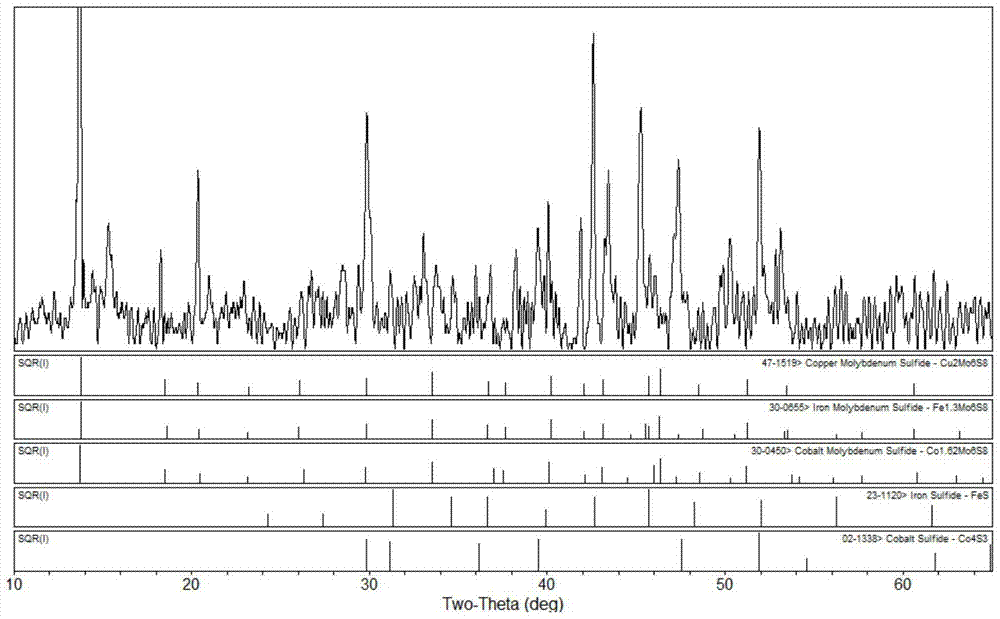A method for simultaneously processing molybdenite and white metal
A simultaneous treatment of molybdenite and molybdenite, applied in the field of non-ferrous metallurgy, can solve problems such as harmful emissions, achieve cost savings, easy industrial application, easy recycling and storage and transportation
- Summary
- Abstract
- Description
- Claims
- Application Information
AI Technical Summary
Problems solved by technology
Method used
Image
Examples
Embodiment 1
[0028] White alloy powder (with a particle size of ≤150μm accounting for 99.6%, Fe 15%, Cu 14.5%, Co 37.1%, Si11.1%) and molybdenite (containing Mo 57.92%, S 38.12%) in a mass ratio of 2:1 Mix mechanically, heat to 1500°C, keep warm for 20 minutes and then cool down. After the upper layer slag is separated, the lower layer material is ground to a particle size of ≤150μm, accounting for 95%, and its XRD pattern is shown in figure 1 . Configure 1.0mol·L -1 Sulfuric acid solution, the high-temperature reaction product is leached under oxygen pressure, the oxygen partial pressure is 0.8MPa, the leaching temperature is 120°C, and the leaching time is 1.0h. After mineral phase reconstruction, the total oxidation rate of molybdenum-containing sulfide is 98.67% (60.2% of Mo enters the solution and 39.8% enters the solid phase), the leaching rate of copper is 96.25%, the leaching rate of cobalt is 95.46%, and the leaching rate of iron is 96.65%. Analysis indicated 92.6% conversion o...
Embodiment 2
[0030] White alloy particles (200μm≤particle size≤1000μm accounted for 98%, Fe 10.5%, Cu 24.6%, Co 23.7%, Si8.4%) and molybdenite (containing Mo 48.23%, S 32.40%) by mass ratio 1.5 : 1 Mechanically mix, heat to 1000°C, keep warm for 120min and then cool. After the upper layer slag is separated, the lower layer material is ground to a particle size of ≤300μm, accounting for 95%, and its XRD pattern is shown in figure 2 . Configure 1.0mol·L -1 Sulfuric acid, 1.0mol·L -1 Nitric acid solution, the high temperature reaction product is subjected to normal pressure leaching. The leaching temperature is 80°C, and the leaching time is 1.5h. After mineral phase reconstruction, the total oxidation rate of molybdenum-containing sulfide is 98.86% (44.6% of Mo enters the solution and 55.4% of Mo enters the solid phase), the leaching rate of copper is 95.50%, the leaching rate of cobalt is 95.64%, and the leaching rate of iron is 95.65%. , Chemical analysis showed that the conversion r...
Embodiment 3
[0032] White alloy particles (200μm≤particle size≤1000μm accounted for 98%, Fe 14.5%, Cu 22.5%, Co 34.7%, Si14.1%) and molybdenite (containing Mo 15.86%, S 20.56%) by mass ratio 0.5 : 1 Mechanically mix, heat to 900°C, keep warm for 200min and then cool. After the upper layer slag is separated, the lower layer material is ground to a particle size of ≤300μm, accounting for 95%, and its XRD pattern is shown in image 3 . Configure 1.0mol·L -1 Sulfuric acid, 1.2mol·L -1 The ammonium persulfate solution will leach the high temperature reaction product. The leaching temperature is 80°C, and the leaching time is 2.0h. After mineral phase reconstruction, the total oxidation rate of molybdenum-containing sulfide is 98.36% (34.5% of Mo enters the solution and 65.5% of Mo enters the solid phase), the leaching rate of copper is 96.50%, the leaching rate of cobalt is 95.64%, and the leaching rate of iron is 95.65%. , Chemical analysis showed that the conversion rate of elemental sul...
PUM
| Property | Measurement | Unit |
|---|---|---|
| particle diameter | aaaaa | aaaaa |
Abstract
Description
Claims
Application Information
 Login to View More
Login to View More - Generate Ideas
- Intellectual Property
- Life Sciences
- Materials
- Tech Scout
- Unparalleled Data Quality
- Higher Quality Content
- 60% Fewer Hallucinations
Browse by: Latest US Patents, China's latest patents, Technical Efficacy Thesaurus, Application Domain, Technology Topic, Popular Technical Reports.
© 2025 PatSnap. All rights reserved.Legal|Privacy policy|Modern Slavery Act Transparency Statement|Sitemap|About US| Contact US: help@patsnap.com



